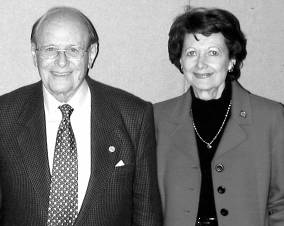![]() George Rosenkranz (born as György Rosenkranz,
August 20, 1916, in
Budapest) is a
Mexican
scientist in steroid research and a professional
bridge player.
George Rosenkranz (born as György Rosenkranz,
August 20, 1916, in
Budapest) is a
Mexican
scientist in steroid research and a professional
bridge player.
He was born in Hungary, educated in Switzerland and lived in Mexico for 66 years. At Syntex corporation, he headed the research groups that synthesized a progestin used in some the first combined oral contraceptive pills and synthesized other useful steroids. He was the Chairman of the Board of the corporation until his retirement in 1996.
Born in Budapest, Hungary, in 1916, Rosenkranz studied chemical engineering at the Swiss Federal Institute of Technology, where he also received a Ph.D. degree. His mentor and future Nobel Prize winner, Lavoslav Ružička, began Rosenkranz's interest in steroid research. However, as Nazi sympathizers were active in Zurich.
Ružička shielded Rosenkranz and other Jewish colleagues, but the scientists soon realized that their stay was putting pressure on their mentor. "We got together and we decided to leave Switzerland to protect him," Rosenkranz said in a 2002 article for the Pan American Health Organization's magazine.
He planned to go to Quito, Ecuador, and chair a university organic chemistry department. However, when while waiting in Havana, Cuba for his ship to Ecuador, the Japanese attacked Pearl Harbor. The United States immediately entered World War II, and the traveller was stuck. Rosenkranz decided to make the best of his situation. He accepted the Cuban president Fulgencio Batista's offer to let all refugees stay in the country and work.
While there, he continued his Zurich work on steroid research. The important role of hormones in human health was already acknowledged by the scientists, but an easy and cheap way to recreate them did not exist yet. Rosenkranz tried using vegetables. He attracted the interest of Syntex; the Mexican company had made a discovery of cabeza de negro, a toxic yam from Mexican hills, produced a steroid that could be transformed into the hormone progesterone. Rosenkranz moved to Mexico City in 1945. However, after a year, the company's co-founders split, and professor Russell Marker left and took his steroid formulas with him. Rosenkranz took his position.
He married Edith Stein in 1945. They have three sons, Roberto, Gerardo, Ricardo, and eight grandchildren. She has origins in Austria and is a good bridge player.
It was a huge challenge. Rosenkranz had to figure out how to recreate Marker's chemical production processes. He didn't have much help: Syntex employed nine lab assistants and only one other chemist. He started working backward, analyzing samples of Marker's work to tease out the ingredients. At the time, Mexico lacked a Ph.D. program in chemistry, so Rosenkranz recruited researchers from Mexico and around the world. When he couldn't find enough fully trained local chemists, he helped set up an Institute of Chemistry at the National Autonomous University of Mexico. He and his colleagues regularly worked at Syntex during the day and then spent the evenings teaching chemistry there. His team was soon reinforced with bright, young chemists, such as Carl Djerassi and Alejandro Zaffaroni. Rosenkranz also started the Institute for Molecular Biology in Palo Alto.
The hires paved the way for Syntex's next big discoveries. In the late 1940s, discovery of cortisone as an arthritis treatment was a hot topic, but no one had been able to create it cheaply and quickly. Rosenkranz's team started working in two shifts, and the long hours of work paid off—in 1951, Rosenkranz and his fellow researchers first submitted a paper on the synthesis of cortisone.
Five months later, under the direction of Djerassi and Rosenkranz, Mexican chemistry student Luis E. Miramontes recreated norethindrone. The company reached an agreement with American company Parke-Davis to market their "superhormone" as a pregnancy aid. Before the two firms were able to complete the deal, other parties had realized a wider use for norethindrone—as a pregnancy inhibitor. Parke-Davis, worried that groups opposed to birth control would boycott its other products, wouldn't market Syntex's product as a contraceptive. By 1962, a Johnson & Johnson division introduced Syntex's norethindrone product as a component of its birth control pill OrthoNovum. In 1964, Syntex came out with its own birth control product, Norinyl.
Rosenkranz understood that peer recognition, not just commercial success, was a key to keep scientists happy and productive. Unlike other pharmaceutical companies, Syntex published most of its steroid research. Between 1961 and 1962, scientists patented 1,378 new steroid compounds, 37% of those owned by Syntex.
"He's someone with enormously high internal standards and abilities, who somehow brings out the best in other people and has a certain infectious optimism, combined with a realistic approach" said Arnold Thackray, president of the Chemical Heritage Foundation.
Rosenkranz gave up his executive positions at Syntex in 1982. Although technically retired for the past 25 years, Rosenkranz is still active in the industry. He is a member of the board of Digital Gene Technologies and president of the advisory board of ICT Mexicana.
In addition to leadership in science, Rosenkranz is a world-class bridge player and one of the most successful in Mexico. He has won 12 North American Bridge Championships and has the rare distinction of having captured all four major team titles: the Grand Nationals, Reisinger, Spingold and Vanderbilt. He has represented Mexico and USA in dozens of world championship events since the early Sixties.
In addition to his playing successes, he has also made significant contributions to bidding theory. He authored the Romex bidding system, an extension of Standard American with many gadgets. He also invented the Rosenkranz double and Rosenkranz redouble and wrote 11 bridge books, most co-written with Philip Alder.
Georges is disappeared in your home in Atherton (CA) 2019, 23 June.



